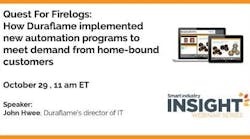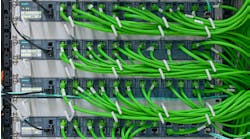Today we preview that presentation, chatting with the Duraflame director of IT about choosing the right integration platform to streamline processes, creating an inventory of partners, and why you should make big moves on Thursdays . Take a look…
Smart Industry: Describe some of the cloud-based integration techniques that Duraflame implemented to respond to this surge in demand.
John: I’d say we benefited most from the agility and repeatability of the processes we implemented, as well as how we addressed security matters. We wanted to gain more agility and control in our processes, as well as repeatability. To get that, we documented our current processes end-to-end, so we could “see” any gaps in them. We basically took inventory of our current systems, data flows, etc., and how they integrate with our on-premises and external systems.
We asked questions like: Are all critical business systems running the latest operating-system patches as well latest application patches? We performed an audit to understand who is able to login to the system and applications. We learned that some of the common EDI order errors were being caused by inaccurate data for new products.
So, we met with our VP of sales and asked that any new items we sell be routed and added by the team responsible for creating new items in our ERP system. We also assessed the risks to keeping our current system as it is, and not doing anything. Plus, we asked ourselves whether we should consider end-of-life scenarios for our OS and applications.
Importantly, we made sure we engaged with our broader team to ask them where they thought we could improve our process. We knew that our senior management would need to get involved sooner rather than later, and this was a way for us to fix processes upstream in order to minimize downstream issues.
I’d say another smart thing that we did was to make sure we had a detailed inventory of all our current trading partners, determining which partners we do the most business with. To answer that we had our business leaders / executive sponsors prioritize our trading partners by revenue.
And of course, before we chose our integration solution, we carefully researched the market, looking for the right platform to fit our situation. We evaluated all the leaders in the integration-software category and asked them how long their platform has been available, and how secure and stable it is. Security is always an important topic, for every business. These days you see more ransomware attacks in on-premises systems than cloud-based systems.
So given where we were in our modernization effort, we worked to answer questions like:
Can moving to the cloud mitigate problems, improve security, and improve uptime? How can we minimize security threats at our company by moving to a cloud platform? And what really are the security threats we face by keeping with our on-premises integrations?
Those are some of the techniques we applied in our situation in our quest to gain more agility and control, repeatability, and security in our integration systems.
Smart Industry: How did you ease reliance on human monitoring and what wins resulted from that?
John: I’d say there are three or four aspects to how we reduced our reliance on manual processes and introduced more automation into our environment. First, we decided on a managed-services (MS) approach. Well actually we took a blended approach because we did want a degree of self-service control as well.
Cleo’s Managed Services team affords us 24 X 7 monitoring and enables us to resolve issues before we even get into the office, which in my case is 6 a.m. Pacific Time. With their help, we documented all our data flows and corrective actions on known issues in our current system and worked with Cleo Managed Services on what they can resolve. Second, we introduced more control over our approach by diagraming clear end-to-end processes and developing playbooks or contingency plans to minimize/eliminate human inaction, depending on the scenario.
For instance, if there are communication errors or integration sites are down, we route tickets to predefined emails. It’s also important to be clear on the so-called “division of labor”—understanding who does what, knowing how and when the cloud provider will monitor and patch applications with no downtime, etc. Understanding how often applications will be patched. Knowing what testing is required for applications patches/releases.
That’s the beauty of a cloud-integration platform, it can be readily updated, with virtually no downtime. By doing these things, we were able to reduce our manual processes and introduce more automation—gaining more agility, flexibility and control over our environment.
Smart Industry: What lesson learned during your digital-transformation experience is most universal / could be best emulated by attendees to your webinar?
John: I’d say we learned a lot, but we’re continuously learning. Here are some key takeaways that I would share with you:
-
Make sure you get senior management buy-in. Executive sponsorship is key on so many levels, and when you have management’s backing, you’re going to get more done faster.
-
Second, if you’re one of those companies that’s modernizing your ERP system, I’d say do not make any ERP/key business system changes while migrating or upgrading your integration solution. In fact, it makes best sense to do integration before ERP.
-
Create repeatable migration process for all trading partners and minimize customization.
-
Ensure there is open, consistent, and strong communication among all parties—the implementation partner, trading partner, and Duraflame teams meet regularly to minimize troubleshooting.
Clarity of purpose and clear communication really matter in projects like these. For instance, clearly defining your migration process, goals and timelines. And make sure to factor in thorough testing and communication to trading partners. Run both current system in parallel, no big-bang migrations.
And determine if you can roll back quickly if required and look for ways to mitigate risk.
The last point I’d make is about timing. We found that what worked best was migrating during the week (Thursday) when transactions volumes are low and not on Friday night because trading partners are not available during the weekend to help fix issues.


